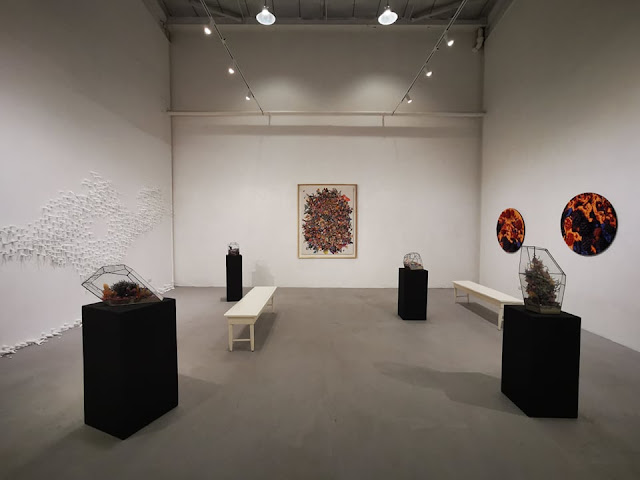"Proof of Life"
"Proof Of Life" by Bea Alcala, Samantha Feleo, and Tekla Tamoria curated by Marz Aglipay.
Artists Bea Alcala, Samantha Feleo, and Tekla Tamoria invite us to bear witness to their exhibition "Proof of Life." Each artist presents evidence of life, whether it is to broach the idea of life from something as small as an organism or even an inanimate object. The artists offer us varied perspectives of living, in order to stretch the viewer’s understanding or acceptance of the fact that the human race is but a mere cog in the hierarchy of life.
This inquisition entreats its audience to sublate their understanding of life by presenting these proofs of life in the foreground against the human race. Audiences are given room to consider a bigger picture of what encapsulates “Life" or living creatures, as humans cannot possibly begin to comprehend the vastness of lifeforms of the Earth alone.
Samantha Feleo's sculptures capture our imagination with the hybridity of her medium which is made of clay, epoxy, and artificially-grown crystals. These amalgamations of appended parts onto her sculpture can be likened to spores or nematocysts present in some species of underwater flora. To achieve this, Feleo takes an exhaustive approach in building and deconstructing these sculptures until she feels that it is time to give them a sanctum.
The idea of placing these sculptures in glass alludes to the literature of Antoine de Saint-Exupéry’s The Little Prince. One can deduce the amount of attention and affection the artists give her sculptures in the same manner the Prince does to the rose. Ultimately, this glass case adds a new layer of meaning to the work which invites the viewer to consider investing time in taking care of objects and systems as we do in creating new ones.
These sculptures are augmented with one wall-bound work "A Grain of Sugar" which was part of Feleo’s exhibition "Horizon of Expectations." The collage magnifies the imagery of her sculptures, a product of the artist gathering cutouts of insects, gems, rocks, and more in a span of 6 years.
Together, these works give us a chance to revisit Feleo's practice involving a medium that she has either preserved or captured in its newly morphed state. These sculptures are not simply treated as objects but a lot like avatars of scarce living creatures.
Bea Alcala
Bea Alcala's "Carapace Dentata" brings us to consider a life that exists in the domain of the ocean. This idea is suggested through vignettes of sea foams on canvas that are augmented with resin Carapaces or turtle shells placed on top of them. Upon close inspection of these shells, one will see that these carapaces are built with predatory features such as sharp teeth and claw-like defensive features. This unusual physiology is envisioned by the artist onto the species, even if only through this expression, in support of their survival.
Turtles being naturally harmless creatures, had the artist mulling over the resilient quality of this species in spite of being in the constant face of extinction. The steady persistence and patience of this animal communicate a sense of being grounded in moments of chaos.
Alcala developed this series’ concept from her shift in production pace. The artist shifted her practice to observe a slower production pace in order to accommodate lifestyle adjustments caused by an injury that prevents her from engaging in her previous rigorous mode of production. Instead of romanticizing resilience, Alcala’s series offers a perspective of resilience as a condition report or proof of life.
Tekla Tamoria
And finally, Tekla Tamoria explores the realm of cosmic horror, a genre that triggers a visceral fear rooted in our humanity. One that serves as a gateway to fear-mongering ideas. No one is spared from this horror once they begin entertaining these thoughts. In tackling the sublime, the artist hopes to capture the idea of something frightening that is too difficult to be put into words or simply too out-of-this-world to be articulated.
Her installation "The Wall" gives life to an inanimate object, the gallery wall itself. Tamoria forgoes her typically vibrant-colored paper in favor of the bleak shade of a bare gallery wall. "The Wall" personifies a galley wall's frustration of not being able to serve its purpose as a bearer of art. Seeing that the walls remained art-less during the quarantine period, a time when art would be presented virtually, the wall morphs into a sentient vengeful being that longs to reclaim the art that so often hanged from it. The wall, even as an inanimate object, reminds us that with art a wall can be brought back to life.
As viewers dive deeply into the foundations of these works that are rooted in a mix of science and art, we are drawn to reflect on the value of life. That no matter what form it comes in, life should be valued, taken care of, and not be taken for granted. This probe into but a small segment of life hopes to reinvigorate its viewers with a renewed zest for life.
Text by Marz Aglipay
-
This text was published and displayed during the exhibition run.




Comments